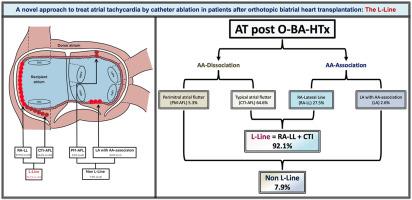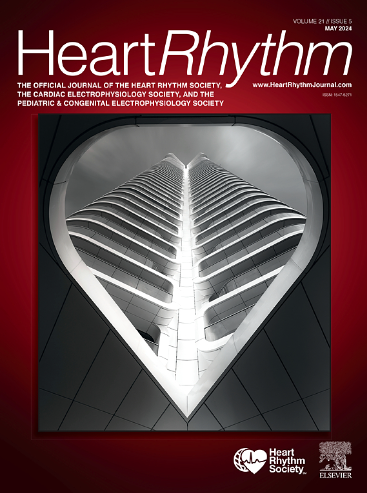原位双心房心脏移植后导管消融治疗房性心动过速的新方法:L-Line。
IF 5.7
2区 医学
Q1 CARDIAC & CARDIOVASCULAR SYSTEMS
引用次数: 0
摘要
背景:房性心动过速(AT)是原位双房心脏移植(O-BA-HTx)后常见的现象。其临床表现、与心房吻合口的关系及电生理特征仍有争议。使用电解剖定位和心肌底物表征的新型射频引导导管消融(RFCA)策略已经出现,但关于其在该患者组中的疗效的数据很少。目的:本研究旨在评估一种新型RFCA治疗O-BA-HTx患者AT的有效性和安全性,并评估长期无心律失常生存期。方法:37例连续O-BA-HTx难治性AT患者在2017-2024年间进行了前瞻性RFCA。评估手术参数、急性和长期预后以及并发症。结果:本组患者(平均年龄56.9±16.3岁,男性占83.8%)接受了AT的RFCA。电生理诊断包括:1。心房分离(AAD):心房扑动(CTI-AFL)依赖于cti (64.6%, n=24)。周围性AFL (PM-AFL) (5.3%, n=2)。2. 房房关联(AAA):右心房(RA) (27.5%, n=10),均涉及外侧传导,其中RA-侧线(RA- ll)成功终止了所有ATs。左心房(LA) (2.6%, n=1)。L-Line入路,结合CTI和RA-LL消融,在92.1% (n=34)的病例中导致AT终止。所有手术均无重大并发症。中位随访26个月[IQR 19-60],仅有2例(5.3%)AT复发。值得注意的是,实现AT的消除与房颤(AF)的消除相关,这突出了解决AT作为AF触发因素的有效性。结论:新型L-Line方法对于O-BA-HTx患者的AT消融是一种安全、有效和可重复的方法,具有良好的长期无心律失常生存。本文章由计算机程序翻译,如有差异,请以英文原文为准。

A novel approach to treat atrial tachycardia by catheter ablation in patients after orthotopic biatrial heart transplantation: The L-line
Background
Atrial tachycardia (AT) is commonly observed after orthotopic biatrial heart transplantation (O-BA-HTx). Its clinical presentation, relationship to atrial anastomoses, and electrophysiologic characteristics remain controversial. Novel radiofrequency-guided catheter ablation (RFCA) strategies using electroanatomical mapping and myocardial substrate characterization have emerged, but data on their efficacy in this patient group are scarce.
Objective
This study aimed to evaluate the efficacy and safety of a novel RFCA strategy for AT in O-BA-HTx patients and assess long-term arrhythmia-free survival.
Methods
Overall, 37 consecutive O-BA-HTx patients with therapy-refractory AT underwent prospectively an RFCA between 2017 and 2024. Procedural parameters, acute and long-term outcomes, and complications were assessed.
Results
The cohort (mean age 56.9 ± 16.3 years, 83.8% male) underwent RFCA of AT. Electrophysiologic diagnoses included:
- 1.Atrio-atrial dissociation:
- •Cavotricuspid isthmus-dependent atrial flutter (64.6%, n = 24).
- •Perimitral atrial flutter (5.3%, n = 2).
- •
- 2.Atrio-atrial association:
- •Right atrium (RA) (27.5%, n = 10), all involving lateral conduction, where an RA-lateral line successfully terminated all ATs.
- •Left atrium (2.6%, n = 1).
- •
The L-line approach, which combines cavotricuspid isthmus and RA-lateral line ablation, was responsible for AT termination in 92.1% (n = 34) of cases. All procedures were performed without any major complications. The median follow-up was 26 months (interquartile range 19–60), and only 2 patients (5.3%) experienced AT recurrence. Remarkably, achieving freedom from AT was associated with freedom from atrial fibrillation, highlighting the effectiveness of addressing AT as a trigger for atrial fibrillation.
Conclusion
The novel L-Line approach is a safe, effective, and reproducible approach for AT ablation in O-BA-HTx patients, with favorable long-term arrhythmia-free survival.
求助全文
通过发布文献求助,成功后即可免费获取论文全文。
去求助
来源期刊

Heart rhythm
医学-心血管系统
CiteScore
10.50
自引率
5.50%
发文量
1465
审稿时长
24 days
期刊介绍:
HeartRhythm, the official Journal of the Heart Rhythm Society and the Cardiac Electrophysiology Society, is a unique journal for fundamental discovery and clinical applicability.
HeartRhythm integrates the entire cardiac electrophysiology (EP) community from basic and clinical academic researchers, private practitioners, engineers, allied professionals, industry, and trainees, all of whom are vital and interdependent members of our EP community.
The Heart Rhythm Society is the international leader in science, education, and advocacy for cardiac arrhythmia professionals and patients, and the primary information resource on heart rhythm disorders. Its mission is to improve the care of patients by promoting research, education, and optimal health care policies and standards.
 求助内容:
求助内容: 应助结果提醒方式:
应助结果提醒方式:


